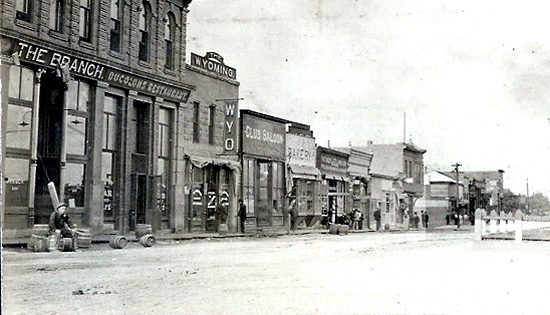
Front Street., Rawlins, Wyo., approx. 1907
All along the Union Pacific as towns were platted, there invariably was a street running parallel to the
railroad tracks. In most instances, this was called "Front Street." In Cheyenne it was Fifteenth Street.
As depicted in the photo, there were the inevitable saloons. One missionary evangelist, the Reverend F. L.Rozelle, passed through the town and
"found a wicked town of 2,000 inhabitants, eight saloons, with dance hall attached; two very small churches on the back
street. One of those churches was trying to hold a revival meeting; counting the preacher, they had
fourteen in attendance." The Reverend Rozelle also visited "one saloon and gambling 'hell' and counted one
hundred men. I can now understand," he wrote, "why the Son of God wept over Jerusalem, and why his
heart broke in the Garden, and why He sweat drops of blood for the sins of the world." Some of the
saloons operated in conjunction with
"hotels" in which damsels of the evening conducted their business. In Rawlins, one such
"hotel" was operated by Messers John Curtis and J. A. Gordon. In their house, there
were some eight damsels. Interestingly, according to the 1880 census, some four of the
inmates were married. One had a two-year old child residing with her in the
facility. Such a saloon was often referred to as the "Red Light Saloon," after a saloon of the same name in
Caldwell, Kansas.
In the cowcamps, the cowboys would sing of The Red Light Saloon and a damsel
within. But the saloon and damsel of which the cowboys sang was not of
the Red Light Saloon in Caldwell, but of a red light saloon in Rawlins. The damsel must have been particularly memorable.
She was able to charge $5.00, expensive for the time, equal to about $200.00 in today's currency. A similar
saloon in Cheyenne charged only $3.00 and included a bath.
The song is so bawdy, leaving nothing to the imagination, that only its first verse and a small portion of the second is repeatable here:
|
I.
I landed in Rawlins and nothing to do
So I took a short walk to the Red Light Saloon.
I opened the door, stepped up to the bar,
Says a dancing young beauty, "Will you have a cigar?"
I took the cigar and sat down in a chair,
'Twas not very long till she crept around there.
She stepped up a-smilin'; sat down on my knee,
"You are a gay fellow, and this I can see."
II
"You are a cowpuncher, and this I do know,
Your muscles are hard from your head to your toe."
She twisted my moustache, she smoothed down my hair;
* * * * |
Writer's notes. There are two versions of the Red Light Saloon, one has been cleaned up. The second, referenced above was
generally sung to the tune of Villikens and his Dinah. There were also
saloons of the same name in Helena, Montana, Fort Worth, and Dallas. The
latter was operated by a "Miss Lillie."
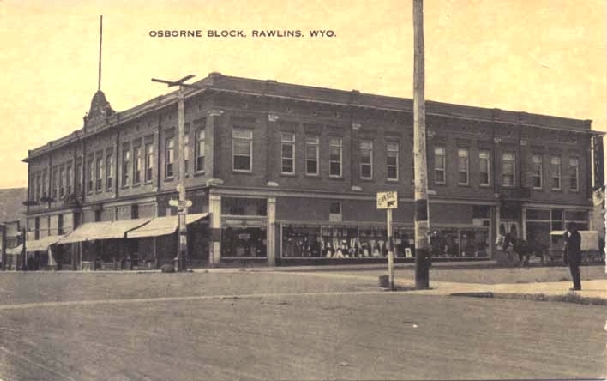
Osborne Block, Rawlins, Wyo., approx. 1910
The Osborne Block constructed by Dr. Osborne opened in 1902 and housed, among other things, the Rawlins National Bank, of which
Dr. Osborne served for a period of time as president. An early news item reported that the
bank had purchased a new pistol "which would be a dangerous thing to stand in from of once it
gets into action." The bank was never robbed.
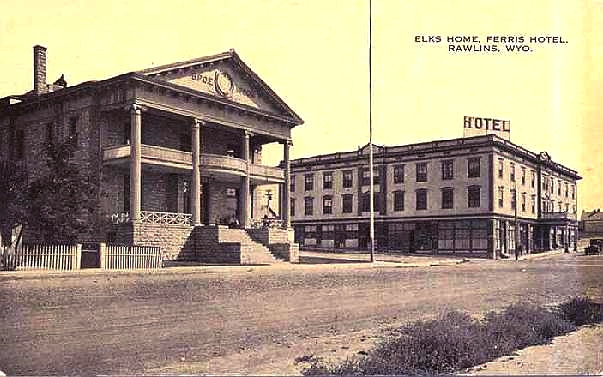
Rawlins Elks Lodge No. 609; beyond is the Ferris Hotel.
The lodge was formed
in 1901. For more on George Ferris, see next page.
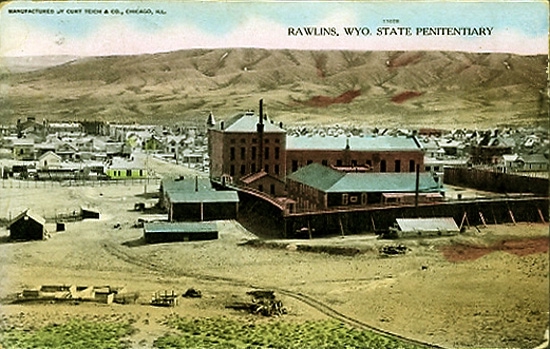
Wyoming State Penitentiary, 1907
With the formation of Wyoming Territory in 1868, provision was made for the construction of
a territorial prison in Laramie City. The prison in Laramie City proved, however, to be inadequate and
territorial prisoners were housed outside of the territory. In some instances only a few
federal prisoners were housed in the Laramie prison. In 1888, Congress authorized the
construction of a new prison in Rawlins. Construction commenced in July of
that year. Construction stalled. In 1893, the state levied 1/8 of mill tax dedicated to the completion of the prison.
Notwithstanding the tax, the prison was not ready to receive transfer
of the inmates from the Laramie facility until December of 1901.
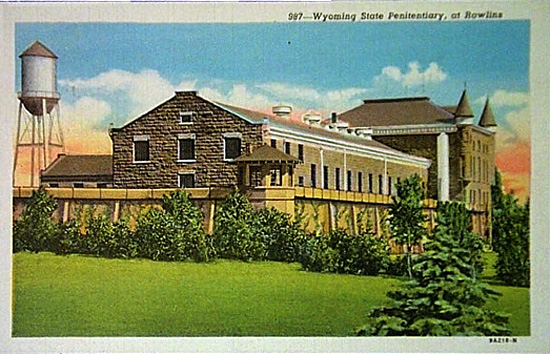
Wyoming State Penitentiary, undated
Conditions in the new prison were less that idealic. It was cold, dank, with no plumbing. The prison, itself,
was operated under contract by Laramie millionaire Otto Gramm (1846-1927).
Gramm was a former State Treasurer, drug store operator, cattleman, tie contractor,
mining speculator, Royal Arch Mason, Knight of Pythias, and Rotarian.
Gramm recieved from the State $.57 per day per prisoner plus the profits from the facility's broom works in which the
inmates worked. The broom works ultimately was burned down by the prisoners in 1912. One inmate, now believed to be
William Stanley Hudson, later wrote in an anonymous manuscript that tomato cans were used for drinking cups and that the
meals consisted of scant servings of hash or boiled beef. The scantiness of the food gave rise to the
speculation that the amount of beans served were calculated down to the last bean, just enough to prevent
starvation. The manuscript, found among prison papers in the Carbon County Museum, was later
published as The Sweet Smell of Sagebrush, Friends of the Old Pen, Inc., Rawlins, 1990. The title was taken from a
paragraph in which the anonymous writer describes being released from the
prison and, rather than going into town, climbed the hill behind the prison to inhale the
sweet smell of the sagebrush. Conditions in the prison were rough. In one instance in 1912, a Frank Wigfall committed a
particularly heinous crime against an elder woman much beloved by both citizens and inmates.
Local authorities, fearful that the local citizenry would seek to avenge the woman, placed
Wigfall in the prison for his own safety. The inmates discovered who Wigfall was and proceeded to
save Carbon County the cost of a trial. In an another instance, an inmate was beaten senseless and then hanged by the
heels in the "Pit." Some prisoners were killed in escape attempts. Several guards were killed. One, W. F. Carrick, was killed in 1911 stopping
an escape attempt. It was his third night on the job.
But if conditions were harsh, they were not as
harsh as in other states. In Oregon, inmates were "leased" out to the operator of an iron
foundry. The operator paid the state. In Florida, there was no state prison. Instead, prisoners were leased out to work in
phosphate mines or malarial turpentine camps. Operators of the turpentine camps paid the
state $150.00 a year for each prisoner. To prevent escape at night from the
camps, the inmates were shackled together. In October, 1905, near Chipley, Florida, the two-story wooden building in
which inmates were housed caught fire. Prisoners attempted to escape by leaping out second floor
windows only to dangle above the ground by the chains connected to others who had already been
overcome by the smoke. As horrified spectators watched, the pitious screams of those
held aloft by the chains ended as the building was consumed by the inferno. Investigation revealed that the
gaurds were drunk. Witnesses reported that drunken guards taunted the dying prisoners as the prisoners begged that
their feet be cut off so they could escape the flames. Yet Florida did not
end the practice of leasing the prisoners until 1923.
In 1911, conditions in the Wyoming State Penitentiary came front and center when the
Democrats nominated as their candidate for governor progressive Republican J. M. Carey. Carey campaigned on a platform of an
eight-hour day for women and children, good roads, the Australian (secret) ballot and termination of
Otto Gramm's contract for the operation of the prison. Judge Carey believed that outdoor work for the
inmates would be healthier than confinement to the dank conditions within the
prison. With Carey's victory, Gramm's contract ended and the State took over
operation of the prison with former Big Horn County sheriff Felix Alston being appointed as the
facility's first warden.
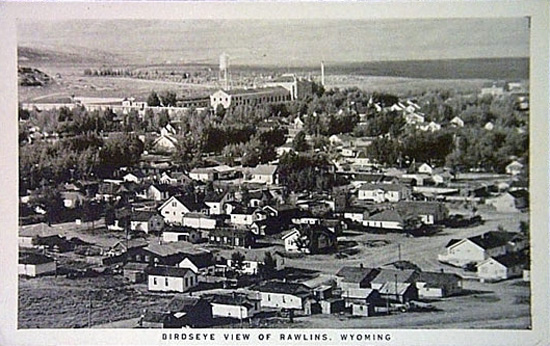
Wyoming State Peniteniary, 1947.
Warden Alston initiated reforms. One of those reforms was the bringing of recreation to the inmates. One of those
programs was baseball. The inmate players wore uniforms with the insignia "WSP," including the teams mascot, Felix Alston, Jr.
The program included two inmates that he had arrested in Big Horn County, George Saban and Herbert Brink.
Both had been sentenced to the penitentiary in connection with the Spring Creek Raid.
Although rodeo may be the state sport, in the beginning years of the 20th
Century baseball was certainly a close second. Indeed, according the Professor Larson, in the late 19th
Century it was the most popular sport in Wyoming. Baseball traces its history to Britain and apparently originated with the
game of "rounders." There is some indication that baseball was played at Valley Forge. Uniform rules, however, orginated prior to the Civil War. The popularity
of the game was spread, however, with the Civil War with it being popular with both Confederates and
Union troops. Across the west baseball was spread by the Army and by miners. Kid Curry played baseball. Geronimo
played the game at Fort Sill. In Wyoming, Baseball was played at Fort Laramie. Army teams
from Fort Robinson played teams in Wyoming. The coming of the railroad to the interior of
Wyoming made inter-city competition possible. Teams were organized in just about every town regardless of population, Cheyenne, Greybull, Lander,
Manderson, Shoshoni, and, of course, Rawlins.
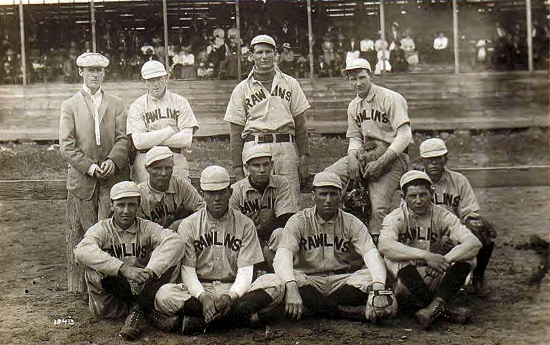
Rawlins City Baseball Team, 1910.
Civilian teams such the Rawlins team as depicted above, sometimes would play the prison teams. It should not be taken
that prison teams were unusual. The New York Times, June 2, 1913, reported on the rivalry between the
eight teams of "United States Penitentiary Baseball League" in Atlanta. As early as 1913, Fulsom Prison had a team. Even today the
San Quintin Giants are famous. Leavenworth was famous for its three teams. Some of the players upon their
release actually went on to professional baseball. Ohio's prison field is named "o. Henry Field" after one the prison's
more famous guests, William Sydney Porter. In Colorado, the prison team was named "Roy's Best" after the
warden, Roy Best.
A recent book by California screen writer,
Chris Enss, Playing for Time: The Death Row All Stars, Arcadia Publishing, 2004, has caused those reforms to reverberate
in controversy. Ms Enss contends that the prison baseball team consisted only of persons on death row and that, with the
connivance of Warden Alston,
a justice of the Wyoming Supreme Court gave stays of execution as long as the team was winning so that
important politicians could bet on the team. One reviewer has referred to the book as
"fiction." Ms Enss quite candidly admits that the book is based on, among other things, rumor:
"The facts surrounding the treatment of the team members, and the alleged gambling on
their games by political figures, has been argued by scholars. But all agree, at the very least, it's a dandy rumor."
Charitably, the book can best be described as containing numerous errors. It starts by
contending that both Butch Cassidy and Frank James were inmates of the prison. As noted above,
the prison did not open until 1901. Butch was a resident six years before at Laramie, not Rawlins.
Alexander Franklin James, the brother of the infamous Jessie James, was residing peacefully in
Missouri as a farmer and co-producer of a wild west show and never inhabited a Wyoming prison.
There was, however, a Frank James who
resided in the early 1920's in the prison, a black from Sweetwater County, not the infamous
Frank James of the James Brothers fame.
Ms Enss lists the members of the team, all of whom she contends were murderers residing on death row:
First Base, Leroy Cooke; second base, George Saban; third base, Jack Carter; Benjamin Owen; catcher, Horace Donavan; Simon Kensler, Darius
Rowan, Lezlo Korda, the three of whom Ms Enss reports killed eight persons; pitcher, William Boyer; and short-stop, Joseph Seng. Of those listed
during the period of which Ms Enss writes, only Seng was on death row. Saban did not, as contended by
Ms Enss, kill his wife and two children, he was, as noted above, involved with the
Spring Creek Raid. It appears likely that first names have been mixed up in the above list. There were several
Wyoming murderers with the same last name: George Cook, Leroy Donovan, and Benjamin Carter. With the exception of
Seng, none of the other names listed appear on the
rolls of those executed in Wyoming nor, with the exception of Seng, do any
of their names appear among those in the prison cemetery. But if Cook, Donovan and Carter played on the team, it would be even more interesting than
any screenplay Ms Enss could devise. Cook was executed in Albany County on December 12, 1884, Donovan in Carbon County on January 18, 1884, and Carter
also in Carbon County on January 27, 1888. See Cook v. Territory of Wyoming, 3 Wyo, 110, 4 P. 887 (1884);
Donovan v. Territory of Wyoming, 2 Wyo, 91, 2 P. 532 (1884); and
Carter v. Territory of Wyoming, 3 Wyo, 193, 18 P. 750 (1888), respectively. One source, indicates that the
team rather than playing over 40 games, played only about three.
Music this page, The Red Light Saloon
Next page, Rawlins continued.
|